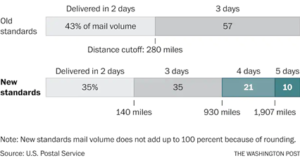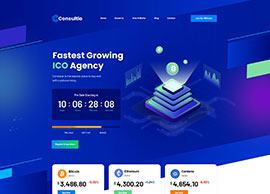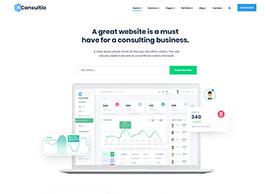
On October 1, 2021 the USPS® announced that First-Class® Mail would slow from 1-3 day to 1-5 day delivery. While they stated that it would not impact 61% of mail, this is only to their targeted objectives which may not be the reality of how your mail had been delivered. The change will be far more reaching because organizations are going to have to change their workflows to adapt to the reduced delivery times. The goal of this article is to give you the areas you need to consider planning for these changes.
The main reason for the slowing of mail is the USPS wants to reduce their dependency on third party air couriers that are expensive and make planning difficult. They want to move most of the mail to truck delivery and be in more control of their delivery standards. This does not impact local deliveries already delivered by truck, but as items go farther throughout the country can make a big change.

Here are the largest changes that mailers will see:
- Although the USPS states that 35% of mail would be delivered in two days, this percentage was higher in the past at 43% and many of these local items were delivered next day. Now the USPS states only local Presorted mail can get next day delivery.
- The cut-off for 2-day mail went from 280 down to 140 miles, further reducing the amount of mail receiving this standard.
- The remainder of mail (57%) used to get 3-day delivery has now been reduced to 35% with many the remainder getting 4-5 day delivery.
- Not all mail will be delivered in the 5-day delivery targets, and based on distances and remote areas, some could be much longer.
Largest Areas of Impact
Now that we are faced with this new reality, it is important that we adjust how we process our largest mail streams to adapt to these changes.
Invoices and Statements – This is the largest single source of First Class® Mail and will have the greatest impact. Sending bills to customers is the lifeblood for millions of companies and they will have to plan for these changes because it will impact their accounts receivable collections. If mail has slower delivery, they will get paid later, impacting cash flows.
Accounts Payable – Most companies try to pay invoices at the latest times possible to maximize their cash flows. Payables going farther distances will have to be paid earlier or late fees, finance charges and collection issues will accrue.
Reminder Mailings – Many organizations send postcard reminders for services. These will have to be planned better to adapt to the slowing mail streams. On a positive note, the USPS just announced new size standards that allows these postcards to be bigger (From 4 ¼” X 6” to 6” X 9”) where more information can now be displayed at the same rate.
Outsourced Mail – Most of the large-scale mailings are not processed in-house and done through third party print and mail services. Where these services are located is now significantly more important. If you are mailing nationally and your service is in New York, it is going to take much longer to reach your farther customers then if provider was based in the Midwest. Also, does your provider have one facility or do they have any ability to distribute your mailing through different locations scattered closer to your customers location. On the converse side, if your mail is primarily local and you are using a mailer in a different part of the country to save money, it may be costing you on increased delivery times.
Visibility Drives Change
The biggest issue we see in most organizations is they do not have the visibility to their mail across the enterprise to know what changes will need to be made. These are the steps that we follow to gain access to the data to quantify the mail spends:
- Start with accounts payable and get an export of the mail spends from the largest mailing vendors and the USPS.
- Get copies of key invoices to see the details on the accounts that are generating mail.
- Reach out to the mailing vendors to gain access to their web portals and link the identified accounts. This provides visibility to mail volumes.
- Go to the largest volume departments identified in the steps above to document their workflows.
Creating a Plan
Now that the largest mail streams have been identified, it is key to come up with a plan to drive change. Here are some areas that need to be considered:
- Invoices may need to be mailed earlier or production times sped up to maintain cash flows.
- Mail volumes from different areas may need to be consolidated into single workstreams to get better postage rates through Presort which can have faster delivery.
- Accounts payable to set up more vendors for ACH payment and adjusts payable time periods for vendors at farther distances that require mailing.
- Outsourced mail be put out to request for proposal (RFP) to identify where it can be produced closest to the customer or more integrated planning is done with partners to speed up when mail is sent.
- Reminder mailings are converted to Presort Services where there is a better chance for local next day delivery.
- Clients can be given incentives for eDelivery eliminating needing to mail.
It is easy to be upset at the USPS for these changes and no one likes reduced service levels. On the flip side, they are adjusting to our rapidly decreasing mail volumes, coupled with more places they need to deliver. If we expect the Post Office to sustain itself through the future, they need to become more cost effective and hopefully this helps them achieve these goals. It is our job as consumers of the Postal Service to adapt to these changes, but to do it in a way where we are in the highest control to optimize our own environments. It will be interesting to see if these changes reduce mail volumes at a greater speed with organizations finding creative ways to eliminate sending mail.















































